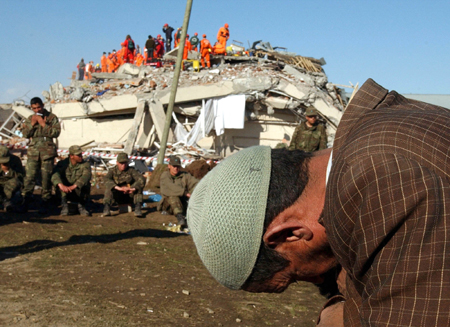Even seconds' notice before the deadly strike of an
earthquake, like the one that hit southeast Turkey yesterday,
could help minimize death and destruction. Advance warning
systems are already in place in Mexico City, Taiwan, and
Japan, but they have yet to be extensively tested. Researchers
have struggled to devise a system for earthquake-prone
Southern California, where the number of faults makes such
calculations difficult. A new method described in the 2 May
issue of Science
gets around this problem and could detect a big earthquake
more quickly than any existing method.
 |
Without warning. Future earthquake detection
systems might help avert tragedies like this crumpled
school dormitory in southeastern Turkey.
CREDIT: DIMITRI MESSINIS/AP
|
Earthquakes consist of two types of waves, S waves and P
waves. The existing early warning systems track S waves, which
create the most damaging ground motion. The proposed Southern
California early warning system, called ElarmS, follows P
waves, which arrive first and cause less damage. The lower the
frequency of the first P waves, the bigger the quake that's
coming. ElarmS' advantage over past systems in Southern
California is that it uses a network of seismic stations
across the region, rather than motion sensors tied to a few
specific faults. This broader setup would detect shaking from
unknown faults, like the one that caused the 1994 Northridge
earthquake.
ElarmS' developers, Richard Allen of the University of
Wisconsin, Madison, and Hiroo Kanamori of the California
Institute of Technology in Pasadena, tested the system on
seismic data from more than 50 earthquakes in Southern
California. For those greater than magnitude 4, the
researchers could provide a rough estimate of magnitude within
1 second of the arrival of the first P wave--or as much as
tens of seconds before damaging S waves showed up. That's
enough time to secure computer systems and nuclear facilities
or even warn people to get away from structures that might
fall--if the system were hooked up to an efficient
communication network. "The big test is to actually get
[ElarmS] running with real data streams," Allen says.
"I think their approach is very clever," says John Evans, a
seismologist at the U.S. Geological Survey in Menlo Park,
California. He likens it to judging whether an elephant or a
squirrel is bearing down on you, by listening to the pitch of
the animal's war cry. A high-pitched squeak is nothing to
worry about, but a low rumble means trouble.
--NAOMI LUBICK
Related sites
Richard
Allen's site on ElarmS
U.S. Geological
Survey ShakeMap
Southern California earthquake
network TriNet

![]() Copyright � 2003 by
the American Association for the Advancement of
Science.
Copyright � 2003 by
the American Association for the Advancement of
Science.